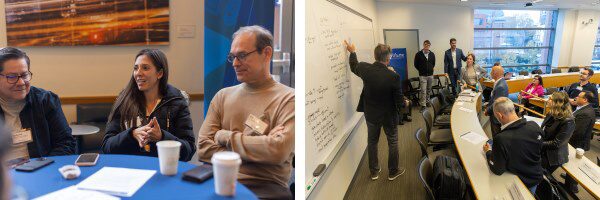The stratospheric rise of Generative AI platforms like ChatGPT and Bard has brought artificial intelligence to the forefront of innovation management. Driving Innovation with Generative AI, a conference jointly presented by the Mack Institute and AI at Wharton, brought together representatives from academia, industry, startups, and the venture capital world to explore this new technology.
Capturing the AI Zeitgeist
 Scott Snyder, Valery Yakubovich, Prasanna Tambe, and Christian Terwiesch
Scott Snyder, Valery Yakubovich, Prasanna Tambe, and Christian Terwiesch
Since ChatGPT’s release in November of 2022, Generative AI has been the subject of endless discussion and debate from both evangelists and detractors. On any given day, your newsfeed is likely to include articles on potential benefits of AI, from improving oncology treatment to helping you pick a holiday gift, as well as warnings of downsides ranging from the mundane to the dire.
A year after its release to the public, every sector of society and every industry is still grappling with this watershed technology. During the conference introduction, presenters offered their perspective on this dynamic, and explained why public interest in Gen AI is unlikely to fade.
“Generative AI caught the attention of executives like nothing I’ve ever seen,” said Scott Snyder, Chief Digital Officer of EVERSANA. He cited statistics showing that 80% of executives think Gen AI will impact their company and industry “significantly” and that 92% of Fortune 500 companies are currently building something with ChatGPT.
“Because we are focused on technology-driven innovation, the Mack Institute is used to technological disruptions of industries,” said Valery Yakubovich, Executive Director of the Mack Institute for Innovation Management. “But this time it is much more personal for us, not only in terms of the high demand for Generative-AI-related innovation projects from our corporate partners, but also in terms of Generative AI’s impact on innovation management itself. The conference’s agenda reflects this dual disruption the Mack Institute is experiencing.”
Prasanna Tambe, Wharton Professor of Operations, Information and Decisions and Faculty Co-Director of AI at Wharton, drew attention to the speed with which Gen AI technology changes and develops.
“I was joking to someone that I put together my slides this morning and they’re probably already out of date,” he said. “It’s not entirely untrue.”
Tambe attributes the rapid improvement in GPT capabilities to the massive investments parent company OpenAI has made in model development and training. From GPT-3 to GPT-4, training costs reportedly increased from just a few million dollars to over $100 million.
“The improvements we see stem largely from these efforts and expenditures,” he explained. “Looking ahead to future models like GPT-5, the training costs are projected to be vastly higher [than $100 million], and it’s an open and exciting question as to how this might improve the overall capabilities of the model and its ability to reason.”
Christian Terwiesch, Wharton Professor of Operations, Information and Decisions and Mack Institute Co-Director, has been featured in The Financial Times and The Wall Street Journal for his viral experiments with ChatGPT. He said he was “blown away” by the vast potential of Gen AI technology and suggested that the next few years will be a “period of discovery.”
“The key question for today is, what does it mean for the management of innovation?” he said. “My colleague Ethan Mollick says that there is a jagged frontier between what humans can do and what AI can do. That line is messy and changing all the time. The challenge for us is to think about workflows that combine the best of AI with the best of humanity.”
Characterizing and Understanding LLMs
 Chris Callison-Burch, Avi Patel, and Tejasvi Devaru
Chris Callison-Burch, Avi Patel, and Tejasvi Devaru
Our first expert panel explored the characteristics of Generative AI and LLMs. Snyder made a distinction between “traditional AI,” which takes complex inputs such as data sets and turns them into simple outputs (such as predictions of home prices or classifications of customers), and new Gen AI models.
“Now we have the capability to take complex inputs and generate complex outputs,” he said. “Not only text, but multiple modes: video, sound, you name it. It’s almost like magic to the average user. I think of traditional AI as being ‘left brained,’ meaning structured and predictable, whereas Gen AI is ‘right brained’: a little bit unpredictable, creative, and intuitive. We’re never quite sure where it’s going to go.”
Chris Callison-Burch, Associate Professor of Computer Science at the University of Pennsylvania, is an expert on Natural Language Processing (NLP) who has testified before Congress about the effect of Gen AI on copyright laws. Though he’s been studying the subject for twenty years, he too had a “career existential crisis” when he saw GPT-3’s capabilities.
“All of the questions that I thought were first order research concerns for natural language processing suddenly seemed, if not solved, much, much easier than before,” he said. “[But] what excites me about these LLMs is that they can be driven with fairly simple instructions. That was one of the breakthroughs of the last year. We’ve fine-tuned the models so that you can tell it what to do in straightforward natural language, and it will be able to accomplish that.”
Callison-Burch sees major potential for the utility and value of Generative AI in the ability to “link” LLMs to external tools, a feature which is currently being developed. This update will allow users to “easily craft a bespoke assistant” via custom instructions and external data, such as company information. With the help of these linked, external tools, your custom AI assistant can use that data to perform daily tasks, make informed decisions, and even perform personal duties like booking flights or shopping online.
Tejasvi Devaru, Vice President of Business Apps & Data at Automation Anywhere, agreed with Callison-Burch that the potential of linking AI to external tools to create automation will be important for business.
“Generative AI is like a brain,” he explained. “It can understand what you are saying and interpret your intent, but it needs arms and legs to put your ideas into action. That’s why automation and Gen AI are a match made in heaven—they come together and unlock more value than Gen AI alone.”
Generative AI’s Value Proposition
 Crissy Behrens, Tito Obaisi, and Kisa Mateene
Crissy Behrens, Tito Obaisi, and Kisa Mateene
Currently, Gen AI is the subject of a huge amount of investor interest, with venture capitalists, tech companies, and enterprises all making significant financial commitments. Our second expert panel was dedicated to understanding these investor trends, as well as effects on traditional product markets and business models, and how startups and incumbents are competing in this burgeoning field.
Kisa Mateene, Director of AI and Startups at Google, compared the stratospheric rise of its valuation to that of cloud computing. Currently, cloud computing is a $400 billion market, growing at 15% per year and expected to reach $1.5 trillion by 2030. In contrast, Generative AI is currently a $100 billion market, but is predicted to become a $1.5 trillion industry by 2030 as well.
“Generative AI was virtually unknown to the public about a year ago,” Mateene said. “Now it’s about to be as big as the cloud industry was originally forecasted to be by the end of the decade.”
The panelists also discussed how Generative AI has changed the startup and incumbent paradigm regarding innovation. While we often think of innovation as emerging from startups, that hasn’t entirely been the case when it comes to Generative AI.
“The biggest difference [between Gen AI and earlier tech innovation waves] is that past paradigm shifts saw innovation come mainly from startups,” said Crissy Behrens, Principal at Insight Partners. “But [with Gen AI], we’re seeing innovation also from enterprises and incumbents.”
Tito Obaisi, Senior Manager of Pipeline & Insights at Comcast’s LIFTLabs, a startup accelerator, thinks that enterprises can develop a “serious competitive advantage” by working with startups in the AI space, which he says often are led by first-time entrepreneurs with academic backgrounds in machine-learning. He offered his advice on how startups and incumbents can collaborate.
“You need a dual approach,” he explained. “You need clear, top-down guidelines, frameworks, and leadership directives outlining the boundaries of what’s feasible and what isn’t. At the same time, it’s equally crucial to maintain a light-touch strategy, enabling organic innovation and energy to ‘bubble up’ from technical leaders within the organizations.”
However, the sheer number of AI startups pose a potential problem to the long-term value of any single one. Mateene compared it to the American automotive industry, which once had many more car manufacturers but has been “winnowed down” over time.
“There are so many, sometimes overlapping, startups that are all working on the same thing,” he said. “We see that in the market every day with news announcements. A startup begins in one direction, but a competitor beats them to market, and they have to pivot. Startups have to be nimble and flexible. They need to focus deeply on a particular idea, but also have the flexibility to be able to pivot when it looks like a competitor may have a superior solution or use-case.”
Ultimately, panelists agreed that the key to driving value might be the same as in any other sector: producing a good product that consumers want. Despite the potentially transformative impact of AI in many sectors, it may not be the right investment for all products or businesses.
“Generative AI is a feature, not a product in itself,” said Obaisi. “It isn’t magically going to keep people using your products. Ask yourself: how sticky was that product before AI was incorporated? Was it a great product already? Are you enhancing the experience of using the product by using AI? That’s going to be the differentiator for a lot of companies.”
>>Take a deep dive: read more about Generative AI’s Value proposition

 Attendees also participated in breakout sessions by industry.
Attendees also participated in breakout sessions by industry.
Generative AI for Innovation Management
 Christian Terwiesch, Mark Spykerman, and Drake Pruitt
Christian Terwiesch, Mark Spykerman, and Drake Pruitt
Our final panel was inspired by Professor Terwiesch’s viral innovation experiment, which compared business ideas generated by ChatGPT with ideas from MBA students, showing that ChatGPT generated higher quality ideas at a faster rate and lower cost.
“[Our experiment] suggests that the critical task in innovation practice may shift from idea generation to idea evaluation and selection, a task for which LLMs do not yet appear to be particularly well suited,” wrote Terwiesch and his co-authors. “It is striking that conventional wisdom prior to 2022 was that AI tools would likely be most useful in rote tasks and that creative work would likely remain the domain of humans. In some ways, the opposite is true of LLMs.”
In other words, Gen AI tools aren’t flawless sources of accurate information, but they excel creatively because they can quickly produce a large number of diverse ideas. Indeed, in Terwiesch’s experiment, ChatGPT showed creativity surpassing that of the average human.
Drake Pruitt, Private Equity Digital Transformation at Amazon Web Services, responded to Terwiesch’s findings, saying that he agreed that the volume and diversity of ideas Gen AI is able to produce will be a boon to innovation.
“Companies have known for a long time that you can’t just ask customers what they would invent,” he said. “For example, with the development of the original smartphone, when companies proposed the idea of combining the functions of a PDA with a mobile phone, customers overwhelmingly rejected it. They couldn’t understand how a ‘smart’ phone would work and saw little need for it.”
“Great innovators are needed to deeply understand their customer and challenge themselves to think big about how to transform their customers’ lives,” he continued. “Gen AI ideation will be a tremendous boost to that process.”
However, that doesn’t mean that human creativity is dead. All the speakers praised Gen AI for its ability to enhance and unlock innovation for everyday people.
“Generative AI has sparked an age of boundless creativity,” argued Mark Spykerman, Chief Information Officer at Cencora. “This innovative technology disrupts traditional creative hindrances like writer’s block or inspiration droughts. With these tools at your fingertips, you’re not just a user but an active collaborator in crafting ideas. Far from being just an amusing novelty, Generative AI is a powerhouse that bolsters productivity and fuels innovation, making these benefits accessible in our day-to-day lives.”
Pruitt says that Gen AI can also be used to smarten up tools to overcome ‘bottlenecks’ created by limitations of knowledge and time. For example, AI co-pilots offer software developers context-aware coding support, helping developers write quality code more efficiently. The same goes for AI-driven creative tools, which will soon allow digital designers to deliver higher quality creative works more rapidly.
“As AI-aided tools become more common, people with less technical backgrounds and experience will be able to express their ideas as builders,” he said. “This will further democratize the innovation process.”
>>Take a deep dive: read more about managing innovation with Generative AI
Wrapping Up
Thanks to greater financial investment and public attention, Generative AI will continue to exponentially improve and to play a larger role in daily life, including in the realm of innovation management. For some, it’s a welcome and exciting development, while, in others, it seems to cause a unique anxiety.
Snyder summed up this imperative as such:
“If you give a carpenter the choice of a nail gun or a hammer, he will likely choose the nail gun because he can complete his task much faster and with less effort,” he said. “But, if you don’t train him in how to operate that nail gun safely, he could really hurt someone. That’s where ethics and guardrails come in. If we establish those, you have the opportunity to use Gen AI to provide employees with the ultimate sidekick, intern, lab assistant, or brainstorming partner.”
“Management scholars are used to dealing with such challenges,” said Yakubovich. “In its early years, Wharton was a neighbor to Frederick Taylor’s scientific management lab, whose inventions raised concerns about people becoming cogs in a machine. Wharton faculty were instrumental to developing institutional and organizational arrangements that reconciled scientific management with human values and aspirations. This time, the concern is that machines will replace humans. Yet, working collaboratively with other stakeholders, management scholars can address this challenge as well.”
Read more about Generative AI’s value proposition and how to use Generative AI to manage innovation.



